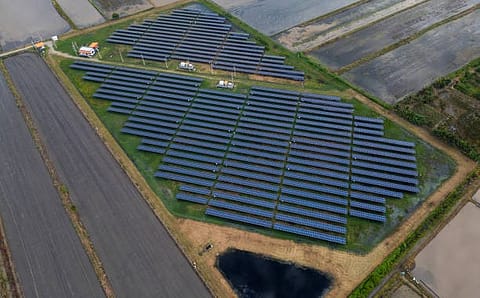India's battery revolution: How zinc-based tech is powering the country’s clean energy future
India is poised to transform its energy storage landscape and drive sustainable growth in the battery sector.

Driven by reduced dependence on lithium-ion batteries, widespread EV adoption and growing decarbonisation efforts, India’s battery manufacturing landscape is priming up with processes and tech trials.
A few companies are already looking to set up factories in India over the next 24-36 months, focusing on different zinc-based chemistries such as zinc-air, zinc-ion, and nickel-zinc.
“India is poised for an extraordinary surge in energy storage capacity, of which Battery Energy Storage Systems (BESS) will be a significant part. At Godrej Enterprises Group, our green and safe rechargeable Zinc Manganese Dioxide battery technology, developed in partnership with Urban Electric Power (USA) and made from earth-abundant, non-toxic, and eco-friendly raw materials, is strategically positioned to support this massive scale-up. In line with our commitment to the ‘Make in India’ initiative, we are developing scalable manufacturing processes for this innovative battery. Our BESS will enable energy transition to fulfil India’s ambitious clean energy goals,” says Jamshyd Godrej, chairman and MD of Godrej Enterprises.
From the perspectives of increasing energy requirements, cost, safety, and sustainability, it is important to promote different battery chemistries and technologies, says Prof. Aravind Kumar Chandiran, Head of the Hyundai Hydrogen Innovation Hub and faculty in the Department of Chemical Engineering at IIT Madras. “Today, we are consuming 2,000 terawatt hours of electricity. By 2050, our requirements are likely to triple. If half of that comes from renewables, and the other half needs to be stored, we would require 1,500 terawatt hours of battery storage, that is 4.1 terawatts per day. The cost of electricity from coal is around ₹8-12. If we combine zinc-air and renewables, the cost could come down to ₹4-4.50,” Chandiran explains the consumption, cost, and energy demand breakdown.
The Zinc-Air Battery (ZAB) Prototype
Of all the chemistries, zinc-air batteries have been a feasible alternative to Li-ion, addressing most of the shortcomings that Li-ion batteries have struggled with. Hindustan Zinc Ltd and IIT Madras, working under a Memorandum of Understanding (MoU), have developed the prototype for electrically-rechargeable zinc-air batteries. These batteries are claimed to be safe for vehicles since they use water-based electrolytes and no flammable materials. Their life cycle is longer than that of lithium-ion. Zinc-air batteries can operate at low power with high energy density—in a given volume of the battery, the total energy stored is equal to or higher than that of lithium-ion systems. “The electrode, which uses oxygen from the ambient air as the reactant, contributes to its high energy density and scalability,” says Prof. Chandiran. The zinc-air battery prototype developed under the said MoU is currently undergoing technology trials.
“Designing batteries tailored to India’s unique environmental, economic, and energy needs requires a technological leap,” says Arun Misra, CEO & Whole-time Director of Hindustan Zinc Ltd. “Zinc-based batteries offer a more stable and viable alternative, as zinc battery technology inherently tolerates high temperatures and is more suitable for India’s conditions. Zinc batteries also offer long-duration storage with a wide operating temperature range. Since zinc resources are locally available, zinc battery technology can benefit from the pro-manufacturing environment of the country,” he tells us.
Recommended Stories
ZAB Trajectory So Far
Zinc-air batteries have been under research for a long time—around a century, to be precise. Zinc is a low-cost, abundant metal that is recyclable and environmentally friendly. Recent research has proven the use of water-based electrolytes and batteries with wider operating temperatures. In fact, zinc-air batteries have already been found suitable for appliances that require a very low rate of discharge, such as hearing aids or sonobuoys.
However, the low rate of discharge leads to poor cyclic stability. “The number of cycles a device can be recharged is the bottleneck we are addressing right now, along with the complexity and scalability of industrial and commercial applications,” explains Chandiran.
“Applications for electric vehicles (EVs), especially four-wheelers, are only possible if the rate of electric discharge is more than 3C for a longer life. Also, the catalysts used in zinc-air batteries are costly. The development of low-cost catalysts is key to making these batteries mainstream,” says Sunil Trikha, Battery Consultant for Lithium-Ion, NiCd, and Advanced Battery Systems.
(INR CR)
Benefits of Indigenisation
The breakthrough, which is expected to be aided by AI, is much awaited for zinc-air battery manufacturing to take off in India. The Union Cabinet’s PLI scheme for the National Programme on Advanced Chemistry Cell (ACC) Battery Storage, with a budgetary outlay of ₹18,100 crores under the Make in India initiative, was approved in 2021 to enhance domestic manufacturing and strengthen the ecosystem for electric mobility and battery storage in the country. Though the PLI scheme will incentivize existing players in the market, more individually tailored schemes are needed to support small and medium manufacturers in transforming lab-scale research into products at scale, says Misra. “The government will need to find ways to integrate micro-factories as part of a gigafactory setup where multiple chemistries can be brought together to help bridge market demand.”
Regarding growth opportunities for small and medium manufacturers, Trikha adds, “There are niche markets requiring specialized designs, like defense, that are ignored by large manufacturers. Innovations are also easier at a smaller scale.”
Of all its features, the easy replaceability and recyclability of zinc are driving market enthusiasm. “Approximately 80% of zinc used globally is sourced from recycled materials. The recycling process for zinc batteries is less energy-intensive and straightforward. Unlike the replacement of whole battery packs in the case of used lithium-ion batteries, used zinc battery cassette packs can be removed and replaced with fully charged ones,” says Misra.
However, to achieve large-scale commercialisation, the market must strictly operate on a circular economy, especially since India does not have the metals required for batteries. “There should be a proper ecosystem to convert recycled materials into battery raw materials,” points out Trikha.